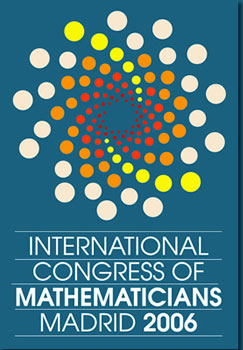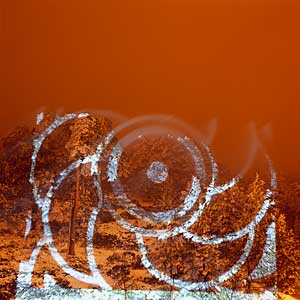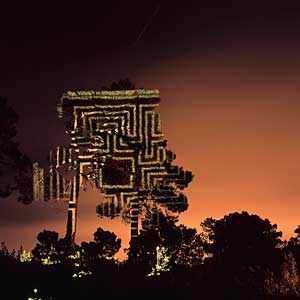
Había comenzado desde antes de haber leído esto, pero a partir de la lectura de este texto comenzó una afinidad por la banda y por su trabajo musical, lirico, visual mucho más grande y justificada, sobre todo por el uso de la serie Fibonacci en su música, el cual está relacionado con el numero áureo y porque aunque más intuitivamente "las canciones tienen algún significado", los cuales uso en mi trabajo de Comunicación y Diseño Gráfico, no sé muy bien hacía donde iría enfocada la búsqueda en éste tema, pero sí sé que tiene muchísimas posibilidades y es un interés personal muy fuerte, quisiera saber ¿qué opinan? y si están de acuerdo (sino están de acuerdo creo que igual lo haría haha), sé que el texto que sigue es un poco largo pero me encantaría que lo leyeran todo para que comprendan un poco el porqué de éste interés hacia el trabajo de esta banda.
To me, Tool's Lateralus is the most amazing piece of music ever composed. I think Tool deliberately wanted to give their fans something truly amazing, but wanted them to find it on their own. "Recognize this as a holy gift..." At first, I thought that the song Lateralus was about tripping acid - discovering true color by seperating the body from the mind. At first listen, I imagined the bending envelope as an intense visual. After becoming more familiar with the track, however, I had reformed my interpretation to something broader: think deeper. Lateralus, perhaps because it is the album's "title track", serves as the central clue for a puzzle that a friend of mine had read about somewhere on the internet. "All I know is that there is a different order for the songs - something about two spirals. Oh yeah, and thirteen is in the middle." After scavenging through endless google search results, I gave up on finding more about this 'alternate order'. Intent to figure the album out, and very curious about the spirals - I put on the proverbial 'thinking cap'. I understood how the spirals could have a lot of significance, in that the album's title track offers the inspiring, "swing on the spiral of our divinity and still be a human..........And following our will and wind we may just go where no one's been. We'll ride the spiral to the end and may just go where no one's been." In my internet scavenging, I had read one review, written by a drummer, who mentioned that Danny Carey's drum beat formed a fibonacci sequence during the song Lateralus. A drummer myself, I decided to get out the graph paper and follow Danny. I can't play like he can, but at least I can hear everything he's doing, and thus was able to construct the drum tabulature. Sure enough, Danny repeats a Fibonacci sequence through the number 13: 1,1,2,3,5,8,13. After 13, he starts again with 1. Bringing in my Algebra 2 knowledge of the Fibonacci sequence, when the equation for the Fibonacci sequence (which I don't actually know) is graphed, it forms a sprial whose vertex depends on the number at which the sequence begins. Coincidence? I began to think not. I had already known of Danny's obsession with sacred geometry and am familiar with Bob Frissell's book, Nothing in This Book Is True, But It's Exactly How Things Are , so the significance of what I had stumbled upon had actually begun to settle in. This is where I just had to play with Lateralus. I had doodled a few spirals in the corners of my graph paper, and in doing so made the first important connection to Lateralus. I knew that if the tracks were in fact intended to be heard in a different order, "Parabol" and "Parabola" would have to go together. In drawing my spirals, I had begun with a vertex and 'spiraled' outwards. After writing the numbers 1 through 13 linearly, I could immediately see that Parabol and Parabola would have to be the middle of my spiral (in that 13 / 2 = 6.5). I drew a simple arrow between 6 and 7 and then pondered the next pair. At first, I actually drew a spiral connecting pairs of numbers whose sum equaled 13 (the number of songs on the album). This, however, left the last track in the same position and without anything to connect to. At this time, I had used my copy of Lateralus and Cool Edit Pro to take out the silences between tracks and put the songs in the following order: 6,7,5,8,4,9,3,10,2,11,1,12,13. The transition from Parabola into Schism blew my mind, as the plucks, probably dismissed by listeners as a drawn out rant of an ending, perfectly transition into the beginning of Schism. When you count out beats as the strings are plucked, Schism resumes with the same time signature and tempo - mirroring the progression of notes. The transition from Schism into Ticks & Leeches is equally intriguing. Schism ends with strong double-kick bass and tom smacks, and Ticks & Leeches begins with what many would call a 'tribal' drum beat. The beat at the very start of Ticks & Leeches is slightly different every subsequent time it is repeated - the measures are two beats longer. Yup - you guessed it - those two beats are ACTUALLY the last two beats of Schism. I can honestly say that I never understood the album's fourth track, Mantra until reordering the album's songs. What I had originally heard as whale calls now had begun to resemble the worst imaginable dry heaves - or a stylized choking. Fitting, seeing as how the last line in Ticks & Leeches is "I hope you choke." After this transition, none of those following it really seemed to make much sense. I certainly didn't like that Disposition and Reflection had been seperated - as they sound quite good when played sequentially on the album. This was the only real roadblock in my disciphering of the Holy Gift. Then I had remembered what my friend had told me - 13 was in the middle. At the time, probably just wanting to believe that there was more to this cd, I had equated this to the positioning of the song "Intermission" on the previous release, Ænema. For the song to be in the 'middle' of the album it would have to be the seventh track in sequence, here having six tracks on either side of it. So I inserted Faaip de Oiad after Lateralus, and almost peed my pants when I discovered that (ever-so-faintly) the fading tone of the last note of Lateralus could be heard in beginning of Faaip de Oiad, and how the distortion of the guitars at the tail end of Lateralus resembled, and later transitioned seamlessly into, the static at the beginning of Faaip de Oiad. The lyrics of Lateralus justify this break in the spiral, almost instructing: "spiral out, keep going, spiral out, keep going." I went back to Lateralus to find the next clue. In Danny Carey's amazingly competent Fibonacci sequence, he had stopped at 13 and gone back to 1. This is what I chose to do to finish the sequence. A second spiral was now constucted, and the order for the Holy Gift now became 6,7,5,8,4,9,13,1,12,2,11,3,10. Already many of you are probably fascinated at what I have revealed to you, but I can not even begin to tell you what this new order has opened up for me. The beauty of Lateralus is very, very fragile and has to be viewed with a very open mind. It can also be different when looked at from different points of view. Aside from the fact that the new order of the songs places them in an order where they flow together nicely - often ending and resuming on the same notes or within the same progression, and some times - in the case of Lateralus into Faaip de Oiad and The Grudge into Triad - even overlapping (though admittadly sound much better when actually electronically overlapped, this is kind of cheating. Consider this a hint, however, if you plan on doing this yourself), the two spirals help to tell a story that every Tool fan should hear. In the interest of not boring the only casually intrigued, I will try to keep this very brief. I would also recommend familiarizing yourselves with Frissell's book (yeah - the one I mentioned earlier). I consider Parabol and Parabola to be quite expository. Maynard wants us to know that no matter what happens, we must all know that this is not our only existance. Our very minds and the contents of our subconscious are intended to be immortal, and if we accept this into our lives (be it because of personal or religious reasons), it will be so. As such, pain is an illusion. At first, I called it "The Lateralus Prophecy" (for reasons you will soon understand), but I have since decided to call the 'reordered' version of Lateralus "The Holy Gift". As Maynard says, "Recognize this as a holy gift and celebrate this chance to be alive and breathing," I take the word "this" to mean much more than just his simple cautioning. Since Parabola is the second track of the Holy Gift, it can be considered at the beginning (esp. considering the context of it's duality with Parabol), and as such, I interpret Maynard's words as more than just clever lyrics in a song. They are a plead for his listeners to listen to everything he has to say and truly celebrate the chance of immortality offered throughout. I would be lying if I said that each song has a specific translation. On the contrary, Tool's music is designed to make you think, not say something specific. It must be treated like great literature - much is hidden contextually. I will elude to Geometric-Drumming's previous post, where he explains the time signatures of Schism: "It represents the title...it's arranged in 12/8 time which is SPLIT into 5/8 and 7/8 - which only really FITS as you PUT THE PIECES BACK TOGETHER." Where Geometric-Drumming claims Schism as his favorite Tool song, I have heard some fans say that it was a retched pick for the album's only single - but I think it was brilliant. Not to downplay the interpretations of those who have posted before me (in fact, I agree with much of what %BlueSoulRobot% has to say), but I think that to the casual listener who knows nothing of Tool, it can be a powerful invitation. Think about it - a lot of dingbats with MTV and a radio would walk around with the words "I know the pieces fit" in their heads. I wonder how many of them took the time to put the pieces back together to (re)discover what is trying to be communicated. I welcome any feedback. I would love to share interpretations of the songs via email - just too lengthy to post here. I would like to offer the following advice: DO NOT use MP3s to digitally reorder Lateralus. A lot of VERY IMPORTANT information is encoded on the actual cd. Ever notice how everyone who has lost or broken that cd has IMMEDIATELY gone out and bought a new copy? I know I have. It's because there are things encoded on the factory pressing of the cd that are lost in the mp3 compression process and any direct copy onto a cd-r. If you want to do it, do it right - I can't stress how important this is. Use the cda tracks as you put it together and maintain all audio fidelity using professional mixing software.
There's a Fibonacci in Maynard's lyrics, specifically the syllables:
black [1]
then [1]
white are [2]
all I see [3]
in my infancy [5]
red and yellow then came to be
reaching out to me [5]
lets me see [3]
there is [2]
so [1]
much [1]
more and [2]
beckons me [3]
to look through to these [5]
infinite possibilities
as below so above and beyond I imagine [13]
drawn outside the lines of reason
push the envelope [5]
watch it bend [3]
I suppose it's not actually a true Fibonacci, since it does reverse itself.
the Fibonacci Sequence. It's basically a string of numbers that when you add a number to the number before it, you get the next number. Starting with the numbers 0 and 1. 0+1=1, so the set now looks like this; 0 1 1. You take the 1 and add the previous number (1) and you get 2. The sequence looks like this; 0 1 1 2. Now you take the 2 and add the previous number and get 3. Now you have 0 1 1 2 3. When you add the 3 and the 2 you get 5. 0 1 2 3 5. 5+3=8. 0 1 1 2 3 5 8. The process continues.
Looking into a mirror but I don't really think I need to reflect.


















